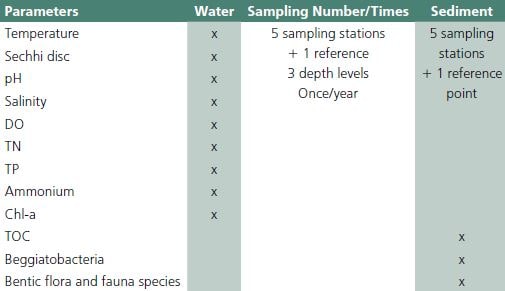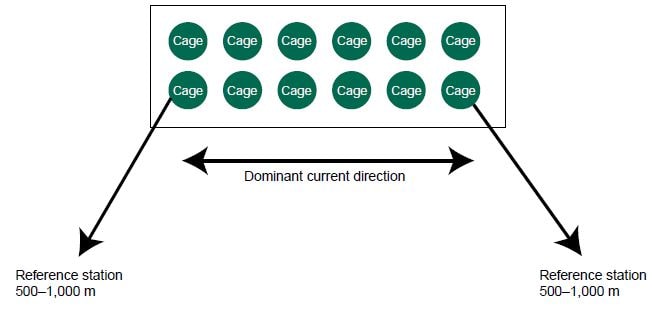3 Monitoring
3.1 Regulatory and Legal Aspects
The Ministry of Food, Agriculture and Livestock (MFAL) and the Ministry of the Environment and Urbanization (MEU) are authorized to control the water quality, sediment in the aquaculture area, and the food health and quality standard on the farms (Figure 6).
The criteria of water pollution (Table 5) has been updated especially for aquaculture. According to standard monitoring programs, the owners of fish farms were asked to monitor the area in the proximity of the fish farm twice a year in the water column (Table 6).
This notification also included the limits for a relevant parameter, defined as the TRIX index. The TRIX index was originally proposed by Vollenweider, et al. (1998).
In the notification it is defined as: TRIX index = [log (Chl-a 3 %O2 3 TIN 3 TP) 1 1:5] 3 0:833.

Figure 5. An investigative example of the potential field of marine aquaculture on Karaburun Peninsula in Izmir Province (MEF, 2008).
Each of the four components represents a trophic
state variable:
Chl-a = chlorophyll-a concentration, as μg L–1;
%O2 = Dissolve Oxygen Deficit percentage;
TIN = Total dissolved inorganic nitrogen (N–NO3 + N–NO2 + N–NH4), as μg L–1)1;
TP = total phosphorus, as μg L–1.
Each year in May and August the results of this monitoring programme must be submitted to the MEU. Regarding the benthic sampling one time every 3 years is sufficient. Sampling is done at five locations (one station is at the centre of the fish cages and others at 20 m distance, at all sites cages) in 3 different depths (the surface, mid-water and bottom of the water column) (Table 6). Reference stations change in the dominant current direction between 500–1,000 meters (Figure 7).
The sample analyses are made at private or public laboratories authorized by the MEU. The monitoring programme is to be done for each parcel in the Mariculture zone in Gulluk Bay. The correct coordinates and monitoring of safety signals of the farm area in relation to marine traffic is controlled and supervised by the Coast Guard and by the Undersecretary of Maritime Affairs.

Figure 6. Monitoring procedures.

Table 5. Water pollution control regulation (MEF, 2004).
3.2 Evaluation
Several papers have been released about the trophic status index (TRIX) and its relation to water quality concern eutrophication in the coastal waters of the Turkish Mediterranean. They originate from a variety of interested parties (IU, 2006; MEDPOL, 2009). A thematic map based on the trophic index data is commonly used to assess eutrophication status. Figure 6 shows that high TRIX values appear, to a great extent, in shallow waters and in the vicinity of fish cages.
The TRIX values that were taken in 2007 were at the bottom only and before any fish farms were moved to
Table 6. Monitoring regulations for fish farms (MEF, 2009).


Figure 7. Monitoring regulations for fish farms (MEF, 2009).
the new mariculture zone. Water quality monitoring parameters, as TRIX values, ranged from 3 to 5. They were obtained from 8 stations which were represented as G1 to G8. Current pollution originates from remnants of previous fish farming activity, inadequately treated sewage, run-off from agricultural facilities or uncontrolled coastal development. From the TRIX data points, GIS software was used to interpolate TRIX values to create a map (Figure 8). On the basis of this map it is to be hoped that other maps will be constructed over time in order to monitor every sector of economic development along the coastline.
TRIX currently is only applied to an aquaculture area that is placed in a bay such as Gulluk Bay, which is now the preserve of holiday homes. Water is no longer tested. Continued monitoring is necessary so as to show whether or not an improved environmental quality has resulted from the moved fish farms. Gulluk Bay provides a case study with a combination of parameters that have to be carefully identified and precisely monitored. To this end legislation to compel ll stakeholders to undertake TRIX examination of their facilities are recommended (Yucel-Gier et al., 2011).